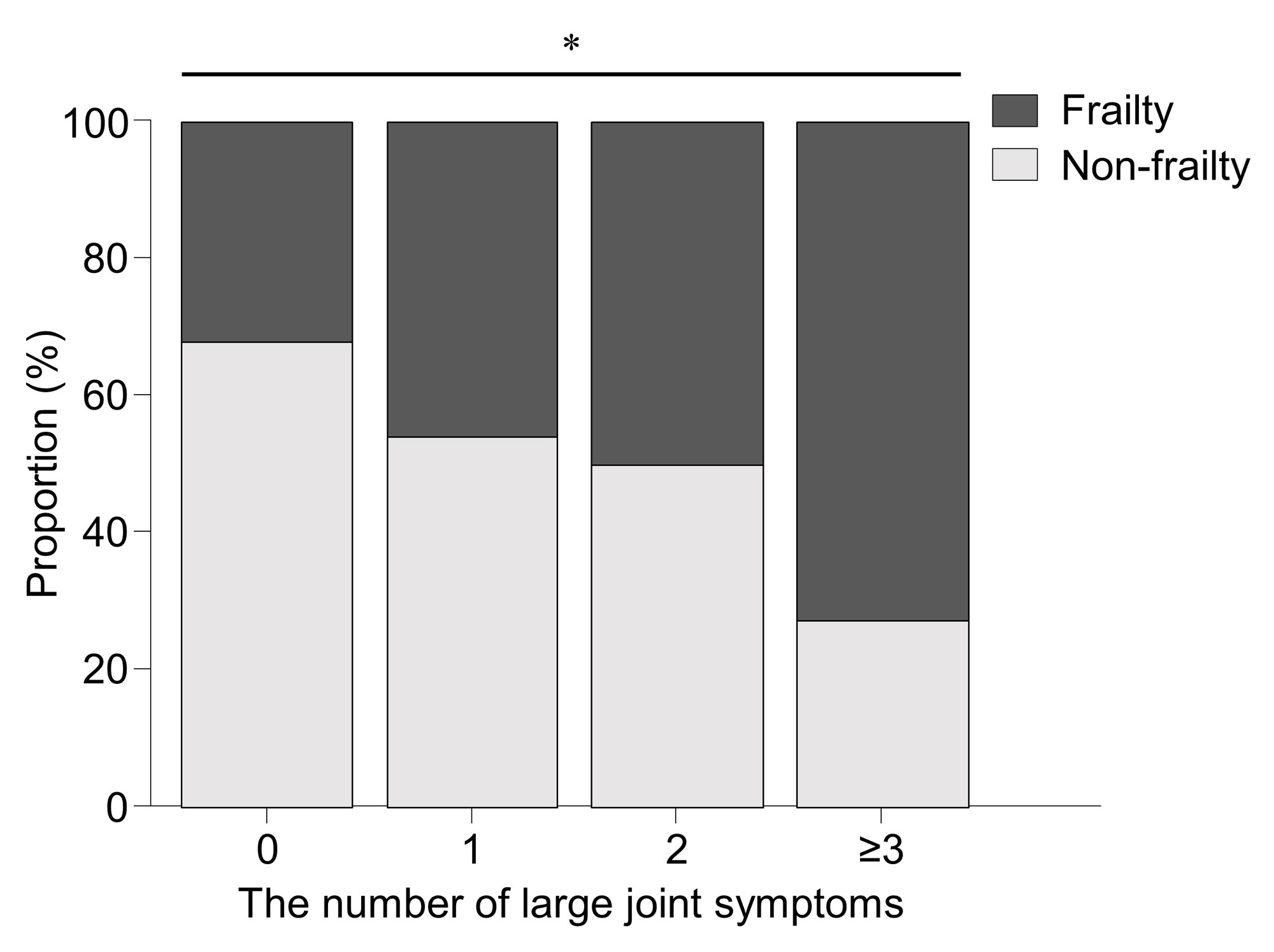Session Information
Date: Tuesday, November 14, 2023
Title: (2095–2140) RA – Diagnosis, Manifestations, and Outcomes Poster III
Session Type: Poster Session C
Session Time: 9:00AM-11:00AM
Background/Purpose: Rheumatoid arthritis (RA) is a causative factor in frailty. Large joint symptoms in RA patients may be more strongly associated with physical disability than small joint symptoms. The aim of this study was to investigate the relationship between large joint symptoms and frailty in RA patients.
Methods: The T-FLAG (Tsurumai – Frailty and Locomotive syndrome of rheumatoid Arthritis for Globalization) Study included 630 RA patients who consecutively visited our hospitals between June and August 2021, of which 591 had background information available, including Clinical Disease Activity Index (CDAI) and the Kihon Checklist (KCL). Frailty was defined as a KCL score of 8 points or more. Large joint symptoms were defined as tenderness or swelling in any of the following joints: shoulders, elbows, hips, knees, and feet. The cut-off value for the number of large joint symptoms (tender joint count + swollen joint count) associated with frailty was calculated using Receiver Operating Characteristic (ROC) analysis. Furthermore, the odds ratios of large joint symptoms associated with frailty (by site) were determined by a multivariable logistic regression analysis, which was adjusted for age, sex, disease duration, and CDAI.
Results: Out of the 591 patients analyzed, 71.7% were female, with an age of 67.4 ± 13.9 years (mean ± standard deviation), disease duration of 11.8 ± 9.8 years, CDAI of 6.5 ± 7.5, KCL score of 7.2 ± 4.8 points. The proportions of patients with large joint symptoms (shoulders, elbows, hips, knees, and feet) were 13.2%, 10.5%, 7.5%, 20.0%, and 14.2%, respectively. The specificity of large joint symptoms for frailty (proportions of patients without large joint symptoms among those without frailty) was 92.2%, 93.9%, 95.9%, 88.1%, and 92.2%, respectively. The proportion of frailty significantly increased as the number of large joint symptoms increased (p< 0.001, Cochran Armitage trend test). The cut-off value for the number of large joint symptoms associated with frailty was 1 site (specificity 74.4%; sensitivity 51.0%; Area under curve 0.647). Knee joint (odds ratio 1.72, 95% confidence interval 1.02-2.91) and ankle joint (odds ratio 1.81, 95% confidence interval 1.02-3.20) symptoms were significantly associated with frailty.
Conclusion: This study suggests that even one site of large joint symptom in RA patients indicates a high possibility of frailty. Among large joint symptoms, lower extremity disability (specifically, knee and ankle joints) was found to have a significant effect on frailty. Therefore, it may be prudent to adopt a more aggressive intervention of RA treatment for RA patients with large joint symptoms (e.g., elderly-onset RA) to prevent frailty. Additionally, if RA patients have large joint destruction and frailty, total joint replacement surgery may be an effective means of improving frailty. Focusing on large joint symptoms is crucial for the prevention of frailty.
To cite this abstract in AMA style:
Sobue Y, Suzuki M, Ohashi y, Asai S, Imagama S. Relationship Between Frailty and Large Joint Symptoms in Rheumatoid Arthritis Patients [abstract]. Arthritis Rheumatol. 2023; 75 (suppl 9). https://acrabstracts.org/abstract/relationship-between-frailty-and-large-joint-symptoms-in-rheumatoid-arthritis-patients/. Accessed .« Back to ACR Convergence 2023
ACR Meeting Abstracts - https://acrabstracts.org/abstract/relationship-between-frailty-and-large-joint-symptoms-in-rheumatoid-arthritis-patients/

